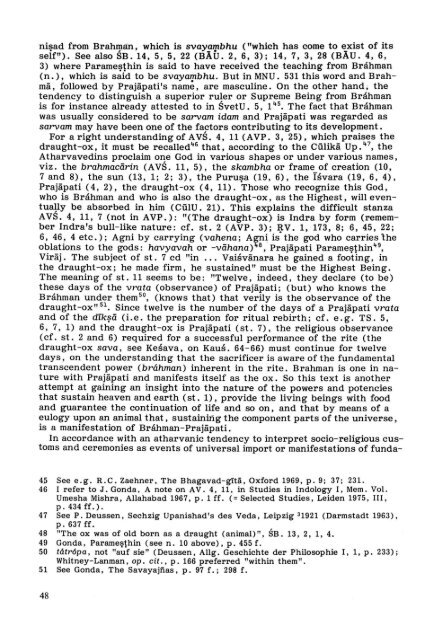Prajapati's relations with Brahman, Brhaspati and Brahma - DWC
Prajapati's relations with Brahman, Brhaspati and Brahma - DWC
Prajapati's relations with Brahman, Brhaspati and Brahma - DWC
You also want an ePaper? Increase the reach of your titles
YUMPU automatically turns print PDFs into web optimized ePapers that Google loves.
ni~ad from Brahmán, which is svaya'1'bhu ("which has come to exist of its<br />
self"). See also SB. 14, 5, 5, 22 (BÄU. 2, 6, 3); 14, 7, 3, 28 (BÄU. 4, 6,<br />
3) where Parame~thin is said to have received the teaching from Bráhman<br />
(n.), which is said to be svayambhu. But in MNU. 531 this word <strong>and</strong> Brahmä,<br />
followed by Prajäpati's namë, are masculine. On the other h<strong>and</strong>, the<br />
tendency to distinguish a superior ruler or Supreme Being from Bráhman<br />
is for instance already attested to in SvetU. 5, 1.,5. The fact that Bráhman<br />
was usually considered to be sarvam idam <strong>and</strong> Prajäpati was regarded as<br />
sarvam may have been one of the factors contributing to its development.<br />
For a right underst<strong>and</strong>ing of AVS. 4, 11 (AVP. 3, 25), which praises the<br />
draught-ox, it must be recalled.,6 that, according to the Cülikä Up . .,7, the<br />
Atharvavedins proclaim one God in various shapes or under various names,<br />
viz. the brahmacärin (A VS. 11, 5), the skambha or frame of creation (10,<br />
7 <strong>and</strong> 8), the sun (13, 1; 2; 3), the Puru~a (19, 6), the Ïsvara (19, 6, 4),<br />
Prajäpati (4, 2), the draught-ox (4, 11). Those who recognize this God,<br />
who is Bráhman <strong>and</strong> who is also the draught-ox, as the Highest , will eventua!ly<br />
be absorbed in him (CülU. 21). This explains the difficult stanza<br />
A VS. 4, 11, 7 (not in AVP.): "(The draught-ox) is Indra by form (remember<br />
Indra's bull-like nature: cf. st. 2 (AVP. 3); RV. 1, 173, 8; 6,45,22;<br />
6, 46, 4 etc.); Agni by carrying (vahena; Agni is· the god who carries lhe<br />
oblations to the gods: havyavah or -vähana).,8, Prajäpati Parame~thin"9,<br />
Viräj. The subject of st. 7 cd "in '" Vaisvänara he gained a footing, in<br />
the draught-ox; he made firm, he sustained" must be the Highest Being.<br />
The meaning of st. 11 seems to be: "Twelve, indeed, they decIare (to be)<br />
these days of the vrata (observance) of Prajäpati; (but) who knows the<br />
Bráhman under them so , (knows that) that verily is the observance of the<br />
draught-ox" 51. Since twelve is the number of the days of a Prajäpati vrata<br />
<strong>and</strong> of the dUqlä (i.e. the preparation for ritual rebirth; cf. e.g. TS. 5,<br />
6, 7, 1) <strong>and</strong> the draught-ox is Prajäpati (st. 7), the religious observance<br />
(cf. st. 2 <strong>and</strong> 6) required for a successful performance of the rite (the<br />
draught-ox sava, see Kesava, on Kaus. 64-66) must continue for twelve<br />
days, on the underst<strong>and</strong>ing that the sacrificer is aware of the fundamental<br />
transcendent power (bráhman) inherent in the rite. <strong><strong>Brahma</strong>n</strong> is one in nature<br />
<strong>with</strong> Prajäpati <strong>and</strong> manifests itself as the ox. So this text is another<br />
attempt at gaining an insight into the nature of the powers <strong>and</strong> potencies<br />
that sustain heaven <strong>and</strong> earth (st. 1), provide the living beings <strong>with</strong> food<br />
<strong>and</strong> guarantee the continuation of life <strong>and</strong> so on, <strong>and</strong> that by means of a<br />
eulogy upon an animal that, sustainiiig the component parts of the universe ,<br />
is a manifestation of Bráhman-Prajäpati.<br />
In accordance <strong>with</strong> an atharvanic tendency to interpret socio-religious customs<br />
<strong>and</strong> ceremonies as events of universal import or manifestations of funda-<br />
45 See e.g. R.e. Zaehner, The Bhagavad-gïtä, Oxford 1969, p. 9; 37 ; 231.<br />
46 I refer to J. Gonda, A note on A V. 4, 11 , in Studies in Indology I, Mem. Vol.<br />
Umesha Mishra, Allahabad 1967, p . 1 ff. (= Selected Studies, Leiden 1975,111,<br />
p. 434 ff.).<br />
47 See P. Deussen , Sechzig Upanishad's des Veda, Leipzig 31921 (Darmstadt 1963),<br />
p. 637 ff.<br />
48 "The ox was of old born as a draught (animal) " , SB. 13,2,1,4.<br />
49 Gonda, Parame!?thin (see n. 10 above) , p. 455 f.<br />
50 tátrópa , not "auf sie" (Deussen, Allg. Geschichte der Philosophie 1,1, p. 233);<br />
Whitney-Lanman, op. eit., p. 166 preferred "<strong>with</strong>in them".<br />
51 See Gonda, The Savayajfias, p. 97 f.; 298 f.<br />
48
















